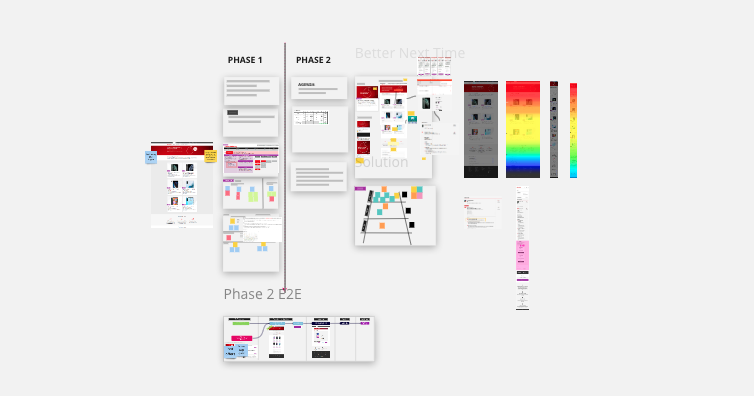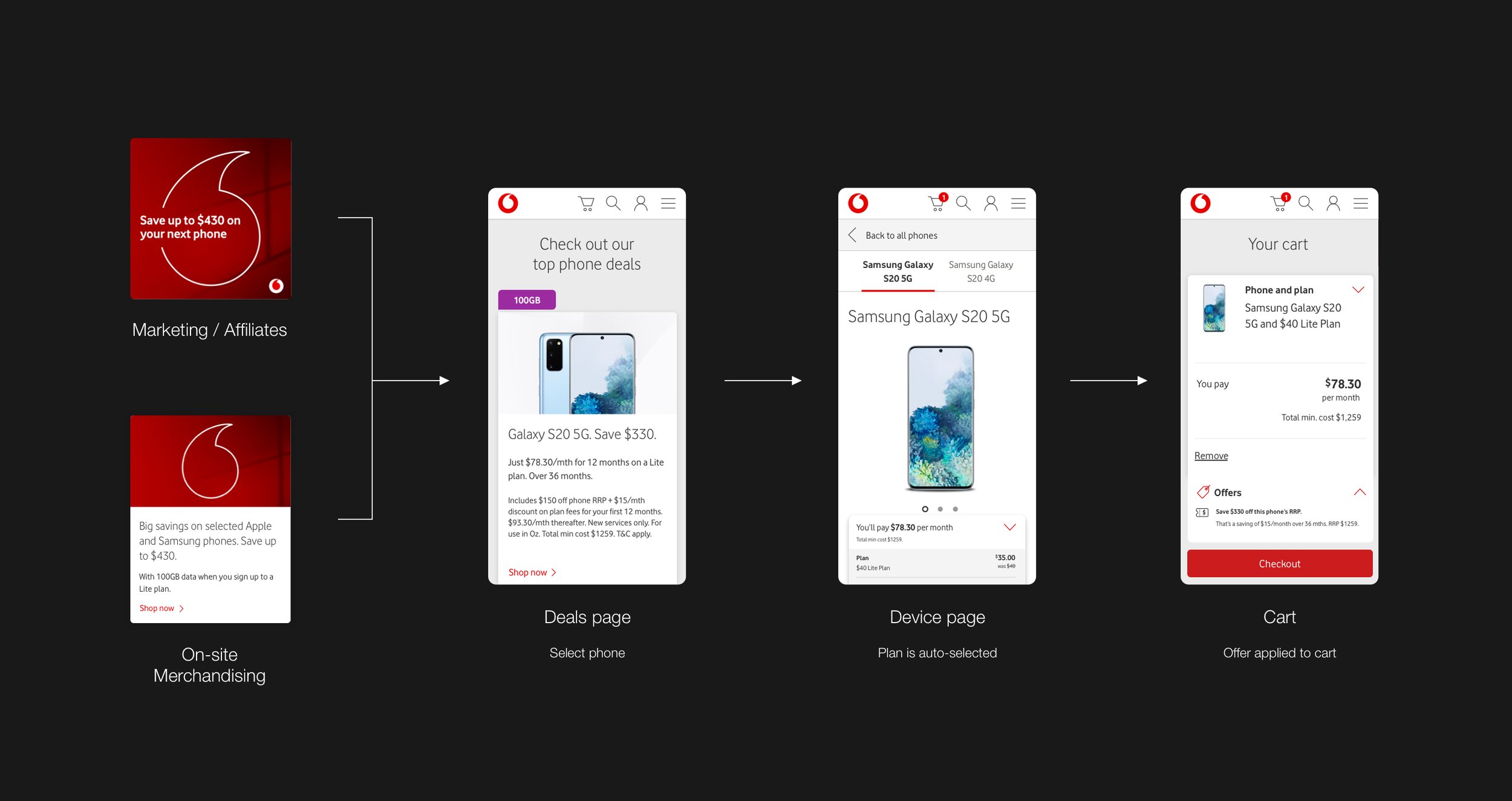Work
Vodafone
“How might we maximise the impact of handset device discounts through deals-led marketing and merchandising?”
Case study for Conversion Rate Optimisation
2020
Working within the Discovery Acquisition team in an agile squad, I was able to complete several initiatives to improve traffic conversion and optimisation to the Vodafone website. For this initiative, we set out to improve the customer journey when looking for handset deals.
Defining the problem
The company’s digital objectives this quarter were to increase acquisition customers across the portfolio through value-led offers. For this sprint, the agile team decided to target customers looking to purchase a new handset through increasing traffic to the site, and increasing conversion through to a successful cart journey.
There were three key objectives for the team;
i. drive incremental traffic to VCA.
ii. design an optimised handset deals page containing the most popular devices sold through the eStore.
iii. increase CVR of handsets through communicating a competitive offer across VCA and through marketing channels.
Identifying the benchmark
Vodafone’s Hot Offers page acts as a central hub for all deals and promotions that are currently offered through vodafone.com.au (VCA). When promotions are advertised through external channels, the customer is taken directly to the campaign landing page. There is no current initiative that directs prospective customers to the VCA deals page.
Our hypothesis
i. If we increase visibility of multiple handset deals to customers through channel marketing
ii. that leads customers to a custom device discount page (and update pricing changes across individual device campaign pages to reflect the discount),
iii. we will see an increase in device orders compared to the existing Hot Offers page.
ii. We can measure the success of the campaign by measuring the conversion rate and cost per order in comparison to the benchmark for always-on device campaigns.
Competitor Research
Telstra
Uses an ongoing deals-led campaign called Handset Money Savers. Channel marketing such as Google and Facebook ads lead prospective customers to the page, and exists as a separate initiative to their always-on device campaigns.
Optus
Has a dedicated page for Deals and Bundles. Mobile device promotions are combined with data-only plans, and home internet bundles. Channel marketing is also utilised for seasonal campaigns.
Strategy and process
Discover, define, design, deliver
The agile team was composed of a designer (myself), a content creator, producer, iteration manager, and a product owner. We reguarly met with the marketing manager to ensure deliverables were confirmed to meet budget and deadlines. Our team took ownership of the end-to-end journey.
Miro workshopping
A kick-off session was started with the team collaborating on MIRO together, where we identified the scope for the project, and a projected timeline. We also had daily stand ups to track progress and highlight any blockers.
Research + design
Customer journey map
To understand the end-to-end acquisition journey for the customer, we used a key Vodafone user persona to map out the typical journey experienced by a customer looking to purchase a device (Postpaid Mobile Acquisition Segment).
We used our knowledge from previous campaigns to understand where traffic to the page will come from, and how the offer is applied through the eStore.
We also identified several potential initiatives to look into in the future; such as creating an exit-intent survey through Hotjar if customers decide to abandon the journey.
CRO initiatives
Device Personalisation
We reviewed recent CRO tests to research relevant findings for this initiative. This A/B test ran from February to March 2020; with the intent to personalise the Mobile Listings Homepage to be more relevant to the user’s device. The filter was auto-selected, determined by the brand of the user’s device. Three categories were tested: iPhone users, Samsung users, and other Android users.
The findings for the A/B test showed that there was a significant increase in engagement and product views. The key learning that we pulled from this test was that users were found to have typically searched for similar devices to the one they were currently using. We also noted that Apple users appeared to show more brand loyalty. We also analysed the types of devices that visited the VCA Mobile Listings Page during the test period. This was a strong indicator of the types of devices we could push in our campaign.
UI Patterns
The team was not able to be supported by developers, so our solution had to be pre-existing in the CMS.
For our previous acquisition campaigns involving multiple devices, our team modified a module (Previous tile) that allowed users to view a breakdown of a device and plan. This was because at the time, we could not use the standard device card due to coding issues. The component was a growth hack on our part. However, we found that the device image was a poor resolution on mobile, and the layout could not be customised.
For this campaign, we needed to provide affordance for call-outs if needed (as some devices may need extra messaging depending on current promotions). We repurposed an existing module, which allowed greater flexibility in how content is presented. This allowed us to emphasise the deals component of the campaign.
Solution and outcomes
Solution and outcomes
Deals page
Informed by these prior learnings, we also observed the top selling handsets for the previous quarter. This led us to prioritise iPhone and Samsung Galaxy products in the device selection of the campaign page.
From observing hotjar insights on similar campaign pages, we noticed that customers would drop off early on in the page. To mitigate this in our solution, we minimised copy to bring the device ranges above the fold on desktop. This also reduced scroll length on mobile for faster comprehension.
Results indicated customers scrolled to the end more often than similar initiatives.
By using non-specific merchandising imagery, we were able to reduce legal and avoid brand approval constraints. Streamlining the creative also allowed each device tile to remain visually consistent across all 6 handsets; which further strengthens the positioning as a strictly device-oriented deal page.
Channel marketing
We utilised existing partnerships with Facebook advertising, Shopback, Cashback, and Google Advertising; made possible by working with the Vodafone Sales + Marketing team.
e2e Journey
Once the customer lands on the deals page, they are presented with the top selling devices on offer. The user selects ‘Shop now’ on their chosen device, and is taken through to the product page. For this initiative, we were not able to modify the breadcrumbs to return the customer to the original deals page.
After selecting their preferred device customisations, the customer is then able to continue their cart checkout journey, as the promotion will be automatically applied.
Performance metrics
Performance metrics
Multivariate testing
As we were testing a new layout configuration for mobile offer pages, we wanted to know how we could best represent the offer across multiple devices. We set up three variations to test different component and copy options. The most effective configuration proved to be Option 1, which had a higher amount of click throughs. More testing is recommended to achieve a higher statistically significant result, however.
On the Hot Offers page, the use of the purple call-out does not have a strict use guideline. We identified the potential in applying the multivariate test to more promotions on the Hot Offers page to test the significance of streamlining the call-out component use case.
Adobe Analytics
Once the offer had lapsed, we analysed its performance, paying special attention to visits from mobile customers. We found that users were typically arriving at the page through flagship iPhone and Samsung devices.
The data showed that we were appealing to customers that were looking for similar devices to their own. We were also able to use this data to inform which devices to highlight in the future.
It is important to note that copy was requested by stakeholders to specifically mention Samsung and Apple in the headline, which may have affected traffic.
Results
We successfully reduced the Cost Per Order (CPO) and increased the Conversion Rate (CVR) of device orders in comparison to the always-on handset deals benchmark.
Google Search has proved to be the most effective channel to drive traffic and conversions for this campaign, with CVR of 2%. However, we did gain valuable learnings from using Social and Discovery ads as part of the campaign. We will continue to monitor and optimise accordingly.
I have omitted the CPO data breakdown due to confidentiality requirements.
Critical reflection
The success of the offer prompted the business to evolve the campaign for future iterations. A higher device discount is planned to increase performance, and the ability to stack offers was granted in the next iteration.
Our recommendations to the company were to continue multivariate testing of how multi-device offers are presented, and to determine which devices to include on the page. This aims to improve the efficacy of promoting multiple relevant devices for customers to directly compare pricing. As the initiative took place in a two-week sprint, we would have benefited from more time to perform detailed A/B testing. In the future, the ability to structure sprints to allow this was recommended to the business.
Upon completion of the sprint the team completed a retrospective, where we assessed pains, gains and shout-outs for the initiative. This allowed us to identify key problems encountered during the sprint. As a result, we were able to chart the problems against potential actions, the expected result from these actions, and assign an owner to create accountability.
digital; ux; ui; experience; wayfinding


















